Site Credits
HOMEPAGE
On the departmental website as paratext: Rembert Hüser, “Looking Good with Kafka,” in The Meaning of Culture: German Studies in the 21st Century, ed. Martin Kagel and Laura Tate Kagel (Hannover: Wehrhahn Verlag, 2009), pp. 225-254 and Alexander Galloway, The Interface Effect (Malden: Polity Press, 2012).
Set 1
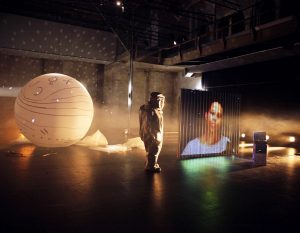
Simone Dede Ayivi, First Black Woman in Space (2016). Photograph by and with permission from Ute Langkafel / Maifoto.
-
-
- Learn more: http://www.simonededeayivi.com/first-black-woman-in-space/ and Priscilla Layne, Out of this World: Afro-German Afrofuturism, under contract with Northwestern University Press, https://www.americanacademy.de/out-of-this-world/.
-
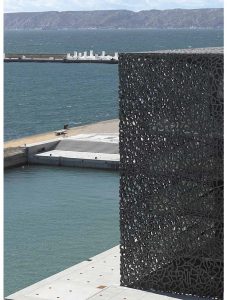
Musée des Civilisations de l’Europe et de la Méditerranée Rudy Ricciotti (architect) and Roland Halbe (photographer) (2013). With permission from Roland Halbe.
-
-
- Learn more: https://www.architecturalreview.com/today/coq-of-the-walk-mucem-marseille-france-by-rudy-ricciotti and Chiara De Cesari, “Museums of Europe: Tangles of Memory, Borders, and Race,” in Museum Anthropology 40:1 (2017), pp. 18-35.
-
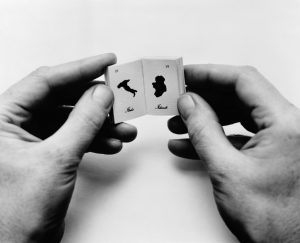
Marcel Broodthaers, La conquête de l’espace. Atlas à l’usage des artistes et militaires (The conquest of space. Atlas for the use of artists and the military) (1975). Lebber Hossmann publisher, Brussels. 38 x 25 mm, 38 pages, offset, boxed. Copyright Estate Marcel Broodthaers. With permission from the Artists’ Rights Society (ARS), New York.
-
-
- Learn more: Deborah Schultz, Marcel Broodthaers: Strategy and Dialogue (Bern: Peter Lang, 2007).
-
Set 2
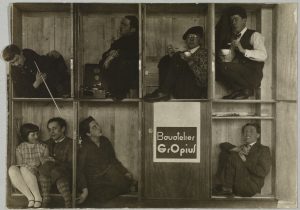
Edmund Collein, Bauatelier Gropius (1927-1928). © Ursula Kirsten-Collein, Berlin. With permission from The J. Paul Getty Museum, Los Angeles.
-
-
- Learn more: https://www.bauhaus.de/en/das_bauhaus/ and Alexander Klose, The Container Principle: How a Box Changes the Way We Think [German: Das Container-Prinzip. Wie eine Box unser Denken verändert, 2009], trans. Charles Marcrum (Cambridge, MA and London: MIT Press, 2015).
-
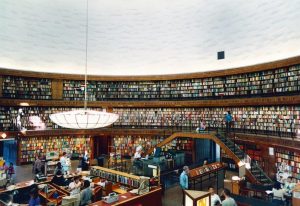
Candida Höfer, Stadtbibliothek Stockholm 1993 (1993). Copyright © 1993 Candida Höfer/VG Bild-Kunst, Bonn. With permission from the artist.
-
-
- Learn more: https://artipelag.se/en/exhibition/candida-hofer/, with an essay by Umberto Eco (Munich, London and New York: Prestel, 2019) and Patience Graybill, “Archiving the Collection: The Aesthetics of Space and Public Cultural Collections in Candida Höfer’s Photography,” in MoveableType 3 (2007), pp. 40-70.
-

Matthieu Godet, Bury me, my Love (2017). The Pixel Hunt, Figs, ARTE France, Dear Villagers. With permission from Pixel Hunt.
-
-
- Learn more: https://www.arte.tv/sites/webproductions/en/bury-me-my-love/, https://www.lemonde.fr/international/visuel/2015/12/18/dans-le-telephone-d-une-migrante-syrienne_4834834_3210.html and Melissa Kagen, “‘Glory to Trumpland!’ Critically Playing Border Games,” in: gamevironments 11 (2019), pp. 23-64.
-
Set 3

Faustin Linyekula, My Body, My Archive (2020), performance view, Studios Kabako (http://www.kabako.org/). Photograph © Tate (Oliver Cowling) (2020). With permission from Tate Images.
-
-
- Learn more: https://www.tate.org.uk/whats-on/tate-modern/exhibition/bmw-tate-live-exhibition-2020 and Virginie Dupray, “Kisangani: a chronicle of return: to realize one fine day that the tales one hopes to tell are not those of exile…,” trans. Allen F. Roberts, in African Arts 46:1 (2013), pp. 30-35.
-

Bookwheel from Agostino Ramelli, Le diverse et artificiose machine (1588).
-
-
- Learn more: Ben Kafka, The Demon of Writing: Powers and Failures of Paperwork (New York: Zone Books, 2012).
-

Postage stamp, “35 Jahre DDR, Wohnungsbau” (1984).
-
-
- Learn more: Rembert Hüser, “Ibiza, DDR,” in Geht Doch, ed. Hanna Engelmeier and Ekkehard Knörer (Berlin: Verbrecher Verlag, 2020), https://www.verbrecherverlag.de/book/detail/983.
-
Set 4
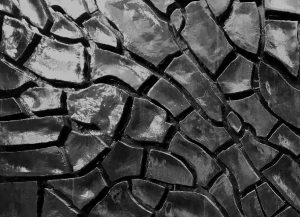
Alberto Burri, Grande Cretto Nero (1976-1977). Franklin D. Murphy Sculpture Garden, fired ceramic. Gift of the artist, 1977. Photograph with permission from Tom Harrison.
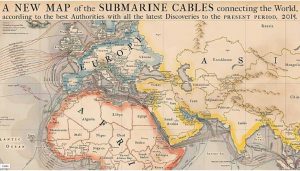
TeleGeography, Submarine Cable Map (2015). With permission from TeleGeography. https://submarine-cable-map-2015.telegeography.com/
-
-
- Learn more: Nicole Starosielski, The Undersea Network (Durham: Duke University Press, 2015) and http://www.surfacing.in/
-
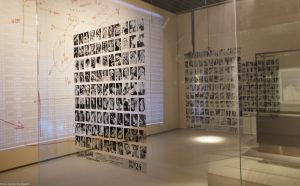
Hotel Pro Forma, Undercover (2010). Photograph by Karsten Bundgaard. With permission from the artists.
-
-
- Learn more: https://www.hotelproforma.dk/project/undercover/ and Annelis Kuhlmann, “Undercover by Hotel Pro Forma, Performing the National Archive: Staging Cultural Heritage at the Royal Library in Copenhagen,” in Performing Archives / Archives of Performance, ed. Rune Gade and Gunhild Borggreen (Copenhagen: Museum Tusculanum Press, 2013), pp. 292-310.
-
Set 5

Hannah Ryggen at the loom, c. 1964, Adresseavisen, Trondheim.
-
-
- Learn more: https://www.schirn.de/en/exhibitions/2019/hannah_ryggen/ and Birgit Schneider, “Programmed Images: Systems of Notation in Seventeenth and Eighteenth-Century Weaving” [German: “Programmierte Bilder. Notationssysteme der Weberei aus dem 17. und 18. Jahrhundert,” 2008], in The Technical Image. A History of Styles in Scientific Imagery, ed. Birgit Schneider, Horst Bredekamp and Vera Dünkel (Chicago: University of Chicago Press, 2015), pp. 142-151.
-
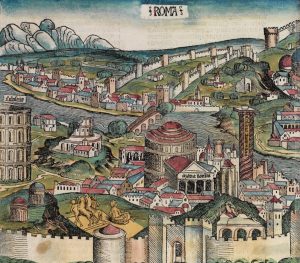
Illustration of Rome from the Nuremberg Chronicle (1493).
-
-
- Learn more: https://cudl.lib.cam.ac.uk/view/PR-INC-00000-A-00007-00002-00888/1 and Christoph Reske, The Production of Schedel’s Nuremberg Chronicle / Die Produktion der Schedelschen Weltchronik in Nürnberg (Wiesbaden: Harrassowitz, 2000).
-

Ménilmonde, Apparences (2016). With permission from the artist.
-
-
- Learn more: https://petapixel.com/2016/01/13/this-video-makes-paris-look-like-the-fake-world-of-a-movie-set/, Tim Bergfelder, Sue Harris, and Sarah Street, Film Architecture and the Transnational Imagination: Set Design in 1930s European Cinema (Amsterdam: Amsterdam University Press, 2007) and Anthony Vidler, “The Explosion of Space: Architecture and the Filmic Imaginary,” in Assemblage 21 (August 1993), pp. 44-59.
-
LANGUAGES
Dutch

GeoCraftNL, “The entire Netherlands in Minecraft” (2015-present).
-
-
- Learn more: https://geocraft.nl/english/ and Bart Simon and Darren Wershler, “Childhood’s End (or, We Have Never Been Modern, Except in Minecraft),” in Cultural Politics 14:3 (2018), pp. 289-303.
-
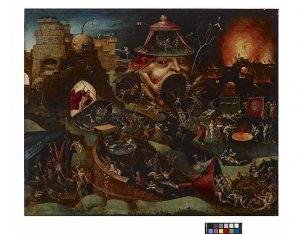
Follower of Hieronymus Bosch, Christ in Limbo (c. 1575), Martha Delzell Memorial Fund.
-
-
- Learn more: Nils Büttner, “Where is Paradise? Imagining Heaven and Hell in Early Modern Times,” in Imagined Worlds: Willful Invention and the Printed Image 1470-2005, ed. Amy Baker Sandback (New York: Axa Gallery and International Print Center, 2005), pp. 37-56.
-

Rutger Hauer in Blade Runner (1982), directed by Ridley Scott, film still, Ladd Company/Warner Bros.
-
-
- Learn more: https://www.theguardian.com/film/2019/jul/25/, Kaja Silverman, “Back to the Future,” in Camera Obscura 27 (1991), pp. 109-132.
-

Madeleijn van den Nieuwenhuizen, “Petition for a statue for former politician and feminist Corry Tendeloo.” Modified photograph for social media circulation and distribution.
-
-
- Learn more: https://www.standbeeldvoorcorrytendeloo.nl/, https://www.vogue.nl/magazine/, https://www.nporadio1.nl/ and Mineke Bosch, “Gender and the Personal in Political Biography: Observations from a Dutch Perspective,” in Journal of Women’s History 21:4 (winter 2009), pp. 13-37.
-
French
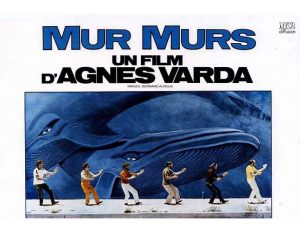
Agnès Varda, Mur Murs (1981), film poster.
-
-
- Learn more: Rita Gonzalez, “Lessons for Reading Los Angeles.” Lecture at the Frankfurt Film Museum (2016), https://www.youtube.com/watch?v=samiqrBMKo0.
-

A bus in Dakar, Senegal, photograph by Dr. Alexey Yakovlev (April 22, 2015), https://www.flickr.com/photos/30628571@N04/49332481098.
-
-
- Learn more: Allen F. Roberts and Mary Nooter Roberts, “A Saint in the City: Sufi Arts of Urban Senegal,” in African Arts 35:4 (winter 2002), pp. 52-73 and 93-96.
-
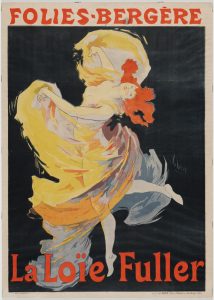
Jules Cheret, Folies-Bergère La Loïe Fuller (1893). Lithograph, printed in color, 48½ x 34½” (123.2 x 87.6 cm). Acquired by Exchange. Digital Image with permission from / © The Museum of Modern Art/Licensed by SCALA/Art Resource, NY.
-
-
- Learn more: Stéphane Mallarmé, “Considérations sur l’art du Ballet et la Loïe Fuller,” in National Observer 9:234 (May 13, 1893), p. 652 and Sonnets & Sonatas, a series of lecture concerts organized by Laure Murat at the Hammer Museum (June 6, 2014), https://sonnetsandsonatas.instantencore.com/web/video_details.aspx?ItemId=1340057 (see 1:16:50-1:24:55).
-
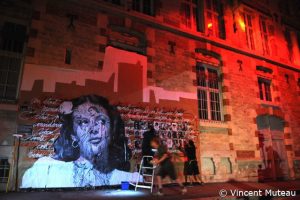
Image of Mémento (2009) by KompleX KapharnaüM. © Vincent Muteau. With permission from the artists.
-
-
- Learn more: http://komplex-kapharnaum.net/fr/projets/memento-2009, https://vimeo.com/kxkm and Lia Brozgal, Absent the Archive: Cultural Traces of a Massacre in Paris, 17 October 1962 (Liverpool: Liverpool University Press, 2020), https://www.liverpooluniversitypress.co.uk/books/id/53133/.
-
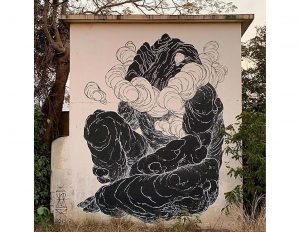
Kid Kréol & Boogie. Image of work from Facebook (August 19, 2019). La Réunion.https://www.facebook.com/kidkreol.boogie/photos/. With permission from the artists.
-
-
- Learn more: https://vimeo.com/314493280, https://www.instagram.com/kidkreol.boogie/ and Magali Compan, “Deeply Rooted in the Present: Contemporary Street Art and Palimpsest Memories on Réunion Island,” in International Journal of Francophone Studies 20:3-4 (2017), pp. 161-182.
-
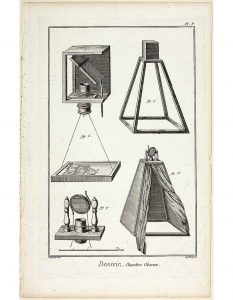
A.J. Defehrt, design: Camera Obscura, from Encyclopédie (1762-1777). Engraving on cream laid paper. The Art Institute of Chicago.
-
-
- Learn more: https://encyclopedie.uchicago.edu/ and Jonathan Crary, Techniques of the Observer: On Vision and Modernity in the Nineteenth Century (Cambridge, MA: MIT Press, 1990).
-
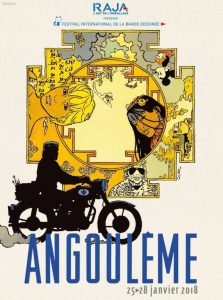
RAJA de l’emballage, Festival International de la Bande Dessinée d’Angoulême (2018), event poster. © Cosey 2018 / 9eArt+. With permission from the artist.
-
-
- Learn more: https://www.comicsbeat.com/the-beat-staff-schedule-in-angouleme-2018/ and Thierry Groensteen, “Narration as Supplement: An Archaeology of the Infra-Narrative Foundations of Comics” [French: “La narration comme supplément. Archéologie des fondations infra-narratives de la bande dessinée,” 1988], in The French Comics Theory Reader, ed. Ann Miller and Bart Beaty (Leuven: Leuven University Press, 2014), pp. 163-181.
-
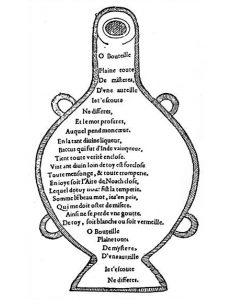
François Rabelais, “Le cinquiesme et dernier livre des faicts et dicts héroïques du bon Pantagruel,” in Œuvres Complètes, ed. Mireille Huchon, with the collaboration of François Moreau (Paris: Gallimard, 1994), p. 831.
-
-
- Learn more: Dick Higgins, Pattern Poetry: Guide to an Unknown Literature (Albany: State University of New York, 1986).
-

CERN Large Hadron Collider – Atlas Building (mural unveiled in 2010, photograph from 2012).
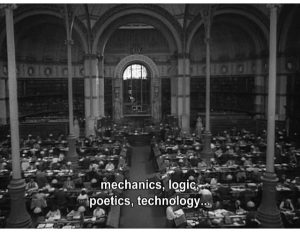
Toute la mémoire du monde, directed by Alain Resnais, © 1956 Les Films de la Pléiade. With permission from Les Films du Jeudi.
-
-
- Learn more: Laura Marcus, “The Library in Film: Order and Mystery,” in The Meaning of the Library: A Cultural History, ed. Alice Crawford (Princeton and Oxford: Princeton University Press, 2015), pp. 199-220 and “The Borgesian Labyrinth of Alain Resnais and Henri Labrouste,” in The Funambulist https://thefunambulist.net/.
-
German

From left, Capt. Macintosh of the British Army translates from French into English, while Margot Bortlin translates from German into English and Lt. Ernest Peter Uiberall monitors the translations at the Nuremberg trials after World War II. With permission from US National Archives, College Park, MD.
-
-
- Learn more: Cornelia Vismann, “Breaks in Language at the Nuremberg Trials” [German: “Sprachbrüche im Nürnberger Kriegsverbrecherprozess,” 2004] translation draft by Kerstin Schroer and Susan Schuppli (June 2011), pp. 2-18, http://law.unimelb.edu.au/__data/assets/pdf_file/0007/2088844/cornelia-vismann-on-language-breaks-at-nuremberg.pdf.
-

belit sağ, (Gegen) die Willkür… (2017), part of “SPOTS: Audiovisual Micro-Interventions for TRIBUNAL ‘Unraveling the NSU Complex’ and beyond” (German: “SPOTS zum TRIBUNAL ‘NSU-Komplex auflösen’ und darüber hinaus”), http://tribunal-spots.net/de/spots/11/#.

Rudolph M. Schindler House, 833 North Kings Road, Los Angeles, Los Angeles County, CA, 1969. Historic American Building Survey, Library of Congress HABS CAL, 19-LOSAN, 68.
-
-
- Learn more: https://makcenter.org/sites/schindler-house/, Robert Sweeney and Judith Sheine, Schindler, Kings Road, and Southern California Modernism (Berkeley and Los Angeles: University of California Press, 2012) and Ehrhard Bahr, Weimar on the Pacific: German Exile Culture in Los Angeles and the Crisis of Modernism (Berkeley: University of California Press, 2008).
-

Maren Kames, Halb Taube, halb Pfau (Berlin: Secession Verlag, 2016), https://halb-taube-halb-pfau.com/. © Image: Maxie Fischer, © Text: Maren Kames. With permission from Maren Kames.
-
-
- Learn more: Hanna Engelmeier, “Halb Buch, halb QR-Code. Mit Maren Kames am Lyriktelefon,” in Zeitschrift für Medienwissenschaft 11:21 (February 2019), pp. 122-132. https://www.zfmedienwissenschaft.de/heft/text/halb-buch-halb-qr-code.
-
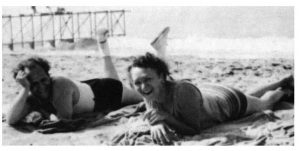
Sergei Eisenstein and Salka Viertel on the beach in Santa Monica, early 1930s. With permission from Wienbibliothek im Rathaus.
-
-
- Learn more: Donna Rifkind, The Sun and Her Stars: Salka Viertel and Hitler’s Exiles in the Golden Age of Hollywood (New York: Other Press, 2020).
-
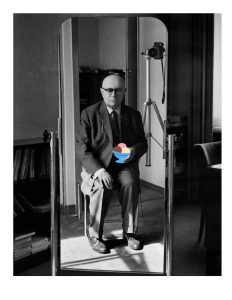
Peter Hintz, “Adorno beim Eis essen,” tweet on July 20, 2020. Reworked photograph of Theodor W. Adorno, “Self in mirror,” 1964.
-
-
- Learn more: Gerhard Richter, “A Portrait of Non-Identity,” in Monatshefte 94:1 (spring 2002: “Rereading Adorno”), pp. 1-9 and Peter Geimer, “Image as Trace: Speculations about an Undead Paradigm” [German: “Das Bild als Spur. Mutmassung über ein untotes Paradigma,” 2007], trans. Kata Gellen, in: Differences 18:1 (2007), pp. 7-28.
-

Eva Knopf, Majubs Reise (2013), film still. With permission from director.
-
-
- Learn more: https://www.youtube.com/watch?v=M25z2Ezh2Ds, Eva Knopf, “Die Suche nach Mohamed Husen im kolonialen Archiv: Ein unmögliches Projekt,” in Archive Dekolonialisieren: Mediale und Epistemische Transformationen in Kunst, Design und Film, ed. Eva Knopf, Sophie Lembcke and Mara Recklies (Berlin: transcript, 2018), pp. 83-106 and Marianne Bechhaus-Gerst, Treu bis in den Tod. Von Deutsch-Ostafrika nach Sachsenhausen. Eine Lebensgeschichte (Berlin: Links Verlag, 2007).
-

Vaginal Davis, Rising Stars, Falling Stars – We Must Have Music! (2012-present), poster. Part of Living Archive Project at Cinema Arsenal in Berlin. With permission from Jeffrey Hilbert/Flagrant Media.
-
-
- Learn more: https://www.arsenal-berlin.de/en/living-archive/about-living-archive/the-project.html, Marc Siegel, “Vaginal Davis’s Gospel Truths,” in Camera Obscura 23:1 (2008), pp. 151-59 and José Esteban Muñoz, “‘The White to Be Angry’: Vaginal Davis’s Terrorist Drag,” in Social Text 52/53 (autumn-winter 1997), pp. 80-103.
-
Italian

Italian keyboard layout.
-
-
- Learn more: James J. Brown Jr. and Nathaniel A. Rivers, “Encomium of QWERTY,” in Rhetoric Through Everyday Things, ed. Scot Barnett and Casey Boyle (Tuscaloosa: The University of Alabama Press, 2016), pp. 212-225.
-
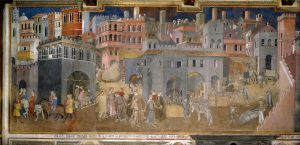
Ambrogio Lorenzetti, Effects of Good Government in the City (1338-1339). Fresco.
-
-
- Learn more: https://www.wga.hu/html_m/l/lorenzet/ambrogio/governme/ and Nicolai Rubinstein, “Political Ideas in Sienese Art: The Frescoes by Ambrogio Lorenzetti and Taddeo di Bartolo in the Palazzo Pubblico,” in Journal of the Warburg and Courtauld Institutes 21:3-4 (July-December 1958), pp. 179-207.
-

Postcard: “A gondolier rows through one of Venice of America’s original canals, now a paved roadway.” With permission from Metro Transportation Research Library and Archive Collection.
-
-
- Learn more: https://www.kcet.org/shows/lost-la/the-lost-canals-of-venice-of-america and Bernhard Siegert, Relays: Literature as an Epoch of the Postal System [German: Relays – Geschichte der Literatur als Epoche der Post 1751-1913, 1993], trans. Kevin Repp (Stanford: Stanford University Press, 1999).
-

Book cover of Transito. Elvira Notari – Kino der Passage, ed. Heide Schlüpmann and Fabian Tietke (Frankfurt am Main: Kinothek Asta Nielsen, 2017). With permission from the editor.
-
-
- Learn more: see above edited volume by Schlüpmann and Tietke as well as https://wfpp.columbia.edu/pioneer/ccp-elvira-notari/.
-

Giorgio Moroder at the Melt! in Ferropolis/Germany, photograph by Stefan Bollmann (2015).
-
-
- Learn more: Robert Fink, Repeating Ourselves: American Minimal Music as Cultural Practice (Berkeley: University of California Press, 2005).
-
Swedish
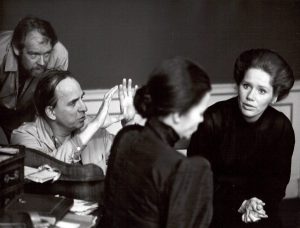
Set of Cries and Whispers (1972) with Liv Ullmann, Sven Nykvist, Ingmar Bergman and Ingrid Thulin. © Bo-Erik Gyberg/AB Svensk Filmindustri (1972). With permission from the Swedish Film Institute.
-
-
- Learn more: https://www.ingmarbergman.se/en and Arne Lunde, “The Story of a Bad Girl!: Summer with Monika, Sexploitation and the Selling of Erotic Bergman in America,” in Beyond Swedish Summers: The Breakthrough of Sexuality in Swedish Cinema, ed. Elisabet Björklund and Mariah Larsson (Jefferson, NC: McFarland, 2016), pp. 11-20.
-
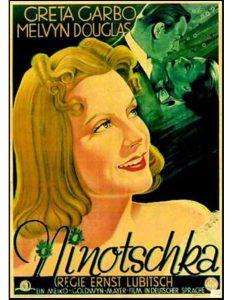
Greta Garbo in German film poster for Ninotchka (1939), directed by Ernst Lubitsch.
-
-
- Learn more: Arne Lunde, “‘Garbo Talks!’: Scandinavians, the Talkie Revolution, and the Crisis of Foreign Voice,” in Nordic Exposures: Scandinavian Identities in Classical Hollywood Cinema (Seattle and London: University of Washington Press, 2010), pp. 90-116 and Rick McCormick, Sex, Politics, and Comedy: The Transnational Cinema of Ernst Lubitsch (Bloomington: Indiana University Press, 2020).
-
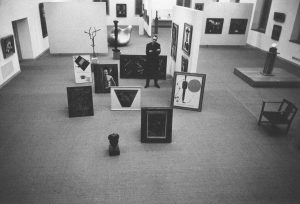
Pontus Hultén in the exhibition Önskemuseet, Moderna Museet (1963). Photograph by Anders Engman/TT/Sipa USA. With permission from TT/Sipa USA.
-
-
- Learn more: https://www.modernamuseet.se/stockholm/en/the-collection/history/, Hans–Ulrich Obrist and Pontus Hultén, “The Hang of It” (interview), in Artforum 36:8 (April 1997), pp. 74-79 and The History Book: On Moderna Museet 1958-2008, ed. Anna Tellgren (Stockholm and Göttingen: Moderna Museet and Steidl Verlag, 2008).
-

Duett För Kannibaler AKA Duet for Cannibals (1969), directed by Susan Sontag, film still. With permission from the Swedish Film Institute.
-
-
- Learn more: https://www.cinema.ucla.edu/events/2020/02/07/sontag-from-the-archive-duet-for-cannibals and Sohnya Sayres, Susan Sontag: The Elegiac Modernist (London and New York: Routledge, 1990).
-

Gorilla 1 (“Konst, Media”) (Stockholm: Bonniers 1966), calendar, ed. Torsten Ekbom, Björn Håkanson, Leif Nylén and Torkel Rasmusson.
-
-
- Learn more: Jesper Olsson, “Rondo and Gorilla – Magazine and Calendar,” in A Cultural History of the Avant-Garde in the Nordic Countries 1950-1975, ed. Tania Ørum (Leiden and Boston: Brill Rodopi, 2016), pp. 195-201 and Gwen Allen, Artists’ Magazines: An Alternative Space for Art (Cambridge, MA: MIT Press, 2011).
-
Yiddish

Soviet Union postage stamp commemorating the centennial of Sholem Aleichem’s birth (1959).
-
-
- Learn more: http://sholemaleichem.org/ and Joshua S. Walden, “The ‘Yidishe Paganini’: Sholem Aleichem’s ‘Stempenyu’, the Music of Yiddish Theatre and the Character of the ‘Shtetl’ Fiddler,” in Journal of the Royal Musical Association 139:1 (2014), pp. 89-136.
-

Cover of Milgroim (September 10, 1922), vol. 2, ed. Mark Wischnitzer, Rachel Bernstein-Wischnitzer and M. Kleinman, Berlin.

Molly Picon (1958).
-
-
- Learn more: https://jwa.org/encyclopedia/article/picon-molly, J. Hoberman, Bridge of Light: Yiddish Film between Two Worlds (New York: Schocken, 1991) and Debra Caplan, Yiddish Empire: The Vilna Troupe, Jewish Theater, and the Art of Itinerancy (Ann Arbor: University of Michigan Press, 2018).
-

Cover of Di Tsukunft (The Future) (October 6, 1917), ed. Abraham Liessin, published by the Forward Association (publishers of the Forverts).
-
-
- Learn more: https://www.jewishvirtuallibrary.org/tsukunft, https://catalog.hathitrust.org/Record/000523251 and Tony Michels, “‘Speaking to Moyshe’: The Early Socialist Yiddish Press and Its Readers,” in Jewish History 14:1 (2000), pp. 51-82.
-

Chava Alberstein, photograph by Ilan (2007).
-
-
- Learn more: https://jwa.org/encyclopedia/article/alberstein-chava and Simon Broughton and Chava Alberstein, “The ‘Joan Baez of Israel’: Simon Broughton talks to Chava Alberstein,” in Jewish Quarterly 43:4 (1996), pp. 55-56.
-

Cover of Rimon (September 10, 1922), ed. Mark Wischnitzer, Rachel Bernstein-Wischnitzer, Moshe Kleinman and Baruch Krupnik, Berlin.

